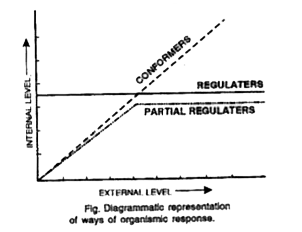How do organisms cope with the different abiotic factors? Explain.
Possibilities to Cope with the Situation. Some possibilities (Fig.) are being discussed here so that the other organisms overcome the situations.
1. Regulate. Some organisms are capable to maintain homeostasis by physiological means and sometimes behavioural also, that maintains constant body temperature, constant osmotic concentration, etc. All birds and mammals, very few lower vertebrates and invertebrates are infact able for such regulation i.e., thermoregulation and osmoregulation. Some biologists believe that die .success of mammals is mainly due to their ability to maintain a constant body temperature and live whether they are in Antarctica or in the Sahara desert.
The mechanisms to regulate their body temperature in most of mammals are similar to that of human beings. Our constant body temperature of 37∘C is regulated in summer when our outside temperature is more than that of body temperature we sweat profusely. The evaporation results cooling, similar to what happens with a desert cooler. It brings down the body temperature. In winter when the surrounding temperature is much lower than 37∘C, we start shivering, a kind of exercise which produces heat and raises the body temperature. Plants do not have such mechanisms to maintain internal body temperatures.
2. Conform. About 99 percent of animals and mostly all plants are not able to maintain a constant internal body environment. Their body temperature changes with die surrounding temperature. In aquatic animals, the body fluid osmotic concentration changes widi mat of the surrounding water osmotic concentration. These animals and plants simply adapt themselves. The benefits of a constant internal environment to the organism had not evolved to become regulators because how many people can afford an air conditioner ? Many people simply .sweat it out’ to maintain internal body temperature in hot summer. Thermoregulation is expensive for many organisms. This is actually true for small animals like shrews and humming birds. Heat loss or heat gain is a function of surface area. Since small animals have a large surface area than to their volume, they lose body heat very fast, when it is cold outside, they have to expend much energy to generate body heat through metabolism. Because of this reason very small animals are rarely found in polar regions. During the process of evolution, the costs as well as benefits of maintaining a constant internal environment are taken into consideration. Some organisms have evolved the ability to regulate, but only for a limited period of environmental conditions, beyond which they usually adapt themselves.
If the unfavourable external conditions remain only for a short time, the organism has two other alternatives being described below.
3. Migrate. The organism can migrate temporarily from the unfavourable habitat to more favourable area and return when unfavourable period is over. This strategy is like a person who is moving from Delhi to Shimla for the duration of summer. Many animals, particularly birds, during winter go long-distance migrations to more favourable areas. Every winter the Keoladeo Ghana (Bharatpur) National Park in Rajasthan receive thousands of migratory birds which come from Siberia and other very cold northern regions.
4. Suspend (Stop for a time). Various kinds of thick walled spores are formed in bacteria, fungi and lower plants which help them survive under unfavourable conditions. These germinate on return of suitable conditions. In higher plants, seeds and some other vegetative reproductive structures cope with the unfavourable conditions besides helping in dispersal. They germinate to form new plants under favourable moisture and temperature conditions. In animals, the organism, if unable to migrate, might avoid the unfavourable environment by escaping in time. For example, bears go into hibernation during winter season to escape in time. Some snails and fish undergo aestivation to avoid summer-related problems like heat and desiccation. Under unfavourable conditions many zooplankton in lakes and ponds are known to enter diapause i.e., stage of suspended development.
Infact, diapause is a stage in the development of certain animals, during which developmental growth is suspended during winter when days are short. Diapause is thus influenced by light, e.g., in winter the larvae of pink cotton ball worm enter into diapause. It is different from hibernation.

Topper's Solved these Questions
- ORGANISMS AND POPULATIONSBOOK - BETTER CHOICE PUBLICATIONCHAPTER - ORGANISMS AND POPULATIONSEXERCISE - LONG ANSWER TYPE QUESTIONS
10 Videos
- MOLECULAR BASIS OF INHERITANCEBOOK - BETTER CHOICE PUBLICATIONCHAPTER - MOLECULAR BASIS OF INHERITANCEEXERCISE - MOST EXPECTED QUESTIONS
36 Videos
- PRINCIPLES AND PROCESSES IN BIOTECHNOLOGY BOOK - BETTER CHOICE PUBLICATIONCHAPTER - PRINCIPLES AND PROCESSES IN BIOTECHNOLOGY EXERCISE - LONG ANSWER TYPE QUESTIONS
16 Videos
Similar Questions
Knowledge Check
Which is not an abiotic factor ?
AfireBsunlightCdecomposerDwater
Write an essay on abiotic factors.
View SolutionHow do organisms cope with stressful external environmental conditions which are localised or of short duration ?
View SolutionHow do organisms cope with stressful external environmental conditions whichare localised or of short duration ?
View SolutionResponses To Abiotic Factors
View SolutionHow do desert lizard cope with the variations in their environment ? Explain.
View Solution[A] : A biotic community exhibits adaptive radiation .
[R] : The organisms of different populations have some features in common due to the effect of the same abiotic factors of the environment .
View Solution[A] : A biotic community exhibits adaptive radiation .
[R] : The organisms of different populations have some features in common due to the effect of the same abiotic factors of the environment .
View Solution
